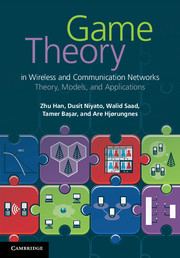Book contents
- Frontmatter
- Contents
- Preface
- 1 Introduction
- 2 Wireless networks: an introduction
- Part I Fundamentals of game theory
- Part II Applications of game theory in communications and networking
- 9 Cellular and broadband wireless access networks
- 10 Wireless local area networks
- 11 Multi-hop networks
- 12 Cooperative-transmission networks
- 13 Cognitive-radio networks
- 14 Internet networks
- References
- Index
13 - Cognitive-radio networks
from Part II - Applications of game theory in communications and networking
Published online by Cambridge University Press: 25 October 2011
- Frontmatter
- Contents
- Preface
- 1 Introduction
- 2 Wireless networks: an introduction
- Part I Fundamentals of game theory
- Part II Applications of game theory in communications and networking
- 9 Cellular and broadband wireless access networks
- 10 Wireless local area networks
- 11 Multi-hop networks
- 12 Cooperative-transmission networks
- 13 Cognitive-radio networks
- 14 Internet networks
- References
- Index
Summary
Cognitive radio [201] is a new paradigm for designing wireless communication systems which aims at enhancing the utilization of the radio-frequency spectrum. The motivation for cognitive radio arises from the scarcity of the available frequency spectrum. Emerging wireless applications will increase spectrum demand from mobile users. However, most of the available radio spectrum has been allocated to existing wireless systems, and only small portions of the radio spectrum can be licensed to new wireless applications. Nonetheless, a study in [143] by the spectrum policy task force (SPTF) of the Federal Communications Commission (FCC) shows that there are also many frequency bands which are only partly occupied or largely unoccupied. For example, spectrum bands allocated to cellular networks in the USA [325] reach their highest utilization during working hours, while they remain unoccupied from midnight until early morning.
The major factor that leads to inefficient use of radio spectrum is the spectrum licensing scheme itself. In traditional spectrum allocation, based on a command-and-control model, where radio spectrum allocated to licensed users (i.e., primary users) is not used, it cannot be utilized by unlicensed users (i.e., secondary users) or applications [87]. Because of this static and inflexible allocation, legacy wireless systems operate only on a dedicated spectrum band, and cannot adapt the transmission band according to the changing environment.
- Type
- Chapter
- Information
- Game Theory in Wireless and Communication NetworksTheory, Models, and Applications, pp. 418 - 459Publisher: Cambridge University PressPrint publication year: 2011



